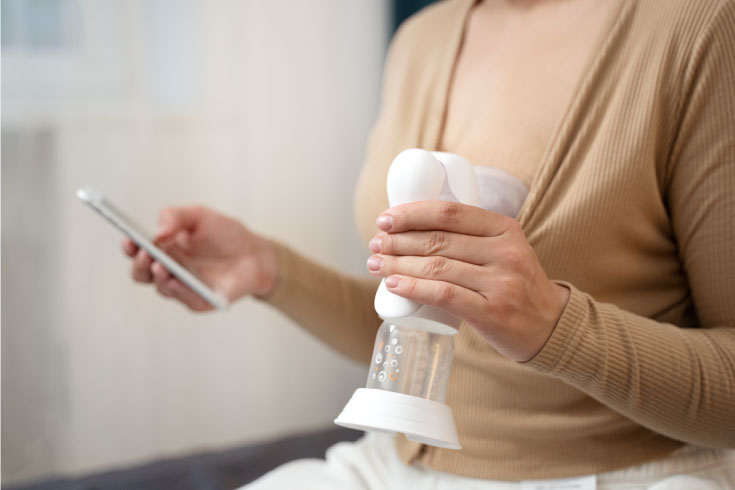Breastfeeding is a natural process. However, chaotic work schedules, unforeseen circumstances, and fatigue may get in the way of feeding your baby. Moreover, gauging what supplies you need can be overwhelming. With multiple breast pumps to choose from, milk storage bags, breast pumping bras, and more to consider, there is certainly a lot to consider.
However, don’t let all these minor inconveniences or complications prevent you from breastfeeding successfully. In this article, let’s understand more about the benefits of breastfeeding from Dr Balkees, a Paediatrician and Lactation Consultant from Pantai Hospital Penang and explore the tools and equipment you can use to make your nursing journey an easier and enjoyable one.
Understanding Breastfeeding and Its Benefits
According to Dr Balkees, breastfeeding is a normal physiological human activity with countless benefits for the mother, child, family, society, and the environment. In the Q&A below, she offers comprehensive insights into how breastfeeding and breast milk can benefit both the mom and baby.
How does breastfeeding impact a child’s health?
Dr Balkees: Breast milk is uniquely suited to the infant’s nutritional needs and is a life substance with unparalleled immunological and anti-inflammatory properties that protect against various illnesses and diseases. Colostrum, or the “first golden milk”, gives newborns an immunity boost while their immune system is developing and supports lifelong health. Most babies will get all the nutrition they need through their mother’s colostrum during the first few days of life.
The benefits of breastfeeding have been found to continue long beyond infancy, even into adulthood. Children who have been breastfed have a lower chance of becoming obese, overweight and developing type 2 diabetes as adults, besides having a higher intelligence quotient. In addition, breastfed infants also experience lower mean blood pressure later in life, which reduces the risk of heart disease.
What are the advantages of nursing for mothers?
Dr Balkees: Breastfeeding also has protective effects for the mother, including decreased risk of postpartum haemorrhage, postpartum depression, heart disease and breast and ovarian cancer. It is also associated with a lower maternal risk of hospitalisation and mortality due to cardiovascular disease in middle-aged and older women. It may offer long-term benefits for maternal cardiovascular health.
Can you talk about how breastfeeding can help a mother and child bond?
Dr Balkees: Breastfeeding is not only excellent for your child’s physical development as it also nurtures the mother and baby emotionally and strengthens the bonding between them due to the increased skin-to-skin contact while nursing. Nursing a child leads to the release of two very important hormones in the mother’s brain: prolactin and oxytocin. Prolactin (the mothering hormone) facilitates breastmilk production and helps moms relax and feel more affectionate toward their babies. Oxytocin (the love hormone) is responsible for milk ejection, the euphoric feelings in the mother, and lifting her mood.
What are the key stages of breastfeeding?
Dr Balkees: For the first six months, breast milk is the only food and drink an infant needs. After six months, a baby will require other types of food in addition to breast milk to ensure healthy growth and development. The transition from exclusive breastfeeding to family food is referred to as complementary feeding and typically covers the period from six to 18 or 24 months of the babies’ age. Breastfeeding should be continued until two years of age and beyond. This is because the first two years of life provide a critical window of opportunity to ensure a child’s appropriate growth and development through optimal feeding.
Did You Know?
The colour of breast milk may vary daily (bluish, yellowish or brownish) depending on the maternal diet.
– Dr Balkees –
Essentials for Breastfeeding
In this section, let’s explore what a nursing mom would need during different stages of breastfeeding.
Nursing accessories for breastfeeding newborns
The first few days with your baby are usually quite hectic, so preparation is vital. Whether you’re still in the hospital or you’ve returned home, these items will provide you with adequate support:
- Nursing bras, night bras, and nursing vest tops
- Nursing nightdresses or pyjamas
- A breastfeeding pillow
- Disposable or washable nursing pads
- Muslin cloths
- Nipple cream for sore nipples
- Nipple formers if you have flat or inverted nipples
In addition, you can also opt for these items if the need arises.
- Nipple shields if your baby struggles to suckle or if you’re suffering from sore nipples. In general, nipple shields are a short-term solution. If pain persists, consult your lactation consultant or breastfeeding specialist.
- A breast pump to relieve engorgement or help establish your milk supply.
- Hydrogel pads can provide soothing effects for some mothers.
If you still encounter problems or things don’t quite go to plan, contact a lactation consultant or breastfeeding specialist for further advice.
Nursing equipment in the weeks that follow
As the first couple of weeks progress, you and your child should be getting more accustomed to one another. The number of feeds can be frequent and time-consuming. Here are a few things to make life easier and more comfortable as you progress:
- Nursing chair so that you and your child can feel more relaxed
- Use a breastfeeding app to keep track of meals
- Have a steady supply of disposable or washable nursing pads
Baby feeding accessories for producing milk
There will come a time when you may want to supply or store more milk for your baby, which means you will require a breast pump. The type of pump you’ll need depends on your situation and how much milk you want to produce.
Apart from the pump, you may also need:
- A steam or cold-water sanitiser
- Microwave sanitising bags and cooler bags
- Breast milk storage bags
- A hands-free pumping bra
Dr Balkees recommends these storage containers to store breast milk properly:
- Hard-sided containers: Usually made from hard plastic or glass, these are the preferred containers for long-term human milk storage. Choose one with an airtight seal.
- Plastic bags (specifically designed for breast milk storage: Only use this option for short-term use as they may spill, leak, or become contaminated more easily than hard-sided containers.
“Wash your hands before expressing milk. Store in small portions (60-120 ml) to minimise waste.
Consider storing smaller portions (30-60 ml) each for unexpected situations. A small amount of milk can keep a baby happy until the mom comes to nurse the baby. You may combine breast milk expressed throughout the day to get the desired volume in a container. Chill the newly expressed milk for at least 1 hour in the main body of the refrigerator or in a cooler with ice or ice packs, and then add it to previously chilled milk expressed on the same day. Do not add warm breast milk to frozen milk because it will partially thaw the frozen milk. Also, do not mix milk from other days. Leave some room at the top of a container because breast milk expands as it freezes. Also, label containers clearly with the date using waterproof labels and ink, if possible,” Dr Balkees advises.
Take Note!
Milk will “separate” during storage. The top of the milk (the cream) will look thicker and whiter. Gently swirl the container to mix the separated milk but avoid vigorously shaking the container.
– Dr Balkees –

Paediatrician & Lactation Consultant
Pantai Hospital Penang



